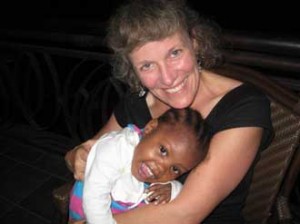
By Jim Engle-Warnick
Esther lives in Carrefour, the epicentre of the Haitian earthquake. She is three. She has been matched to my family for adoption for more than two years. Recently, we received a document with the signature of the President of Haiti, putting the adoption into its end game. It took more than a year to receive this document. Then the earthquake struck.
Esther weighs 18 pounds. She does not know how to run. She has difficulty walking up small inclines. She lives in a small home that houses more than 100 orphans. She does not cry; she has learned that children who cry do not get fed. She has not learned how to talk.
For several days, we did not know if Esther survived the earthquake. When we finally received reliable information that she was alive, we feared the adoption paperwork was likely gone. We were told that the judge who handles adoptions was dead. Post-earthquake security and the possibility of disease filled our thoughts as well.
We made media appearances and circulated petitions to persuade the government of Canada to allow children who have been legally proposed by Haiti to parents who have been approved by Canada into this country. We have watched as the Americans and the Dutch have done exactly that.
Earlier this week, a plane with a handful of these children arrived in Ottawa. Not our Esther, though. A last-minute change in plans by the government left the children in Esther’s orphanage with no one on the ground to identify them.
Tonight, my wife and three other volunteers from our adoption agency are in Port-au-Prince. They spent the entire day at the Canadian embassy handling paperwork for visas. We do not know when they will leave with any of the children. We hope bureaucracy will not continue to trump the extreme urgency of the moment. I
have learned not to hold my breath.
The net effect of the earthquake on the adoption process will probably be to bring Esther here slightly more quickly than had the earthquake not occurred. This is the case with most of the adoptions that are being cleared by the government. This is not the typical effect of the quake on its victims. Here are two such other stories:
Koulou lived in shack in Cité Soleil for 41 years. He was in the process of building a house for his family in a secure neighbourhood. The house collapsed. His story is shown in a video, made by my brother-in-law, John Engle (who has been in Haiti throughout this time with his family), and stored on his YouTube channel: www.youtube.com/user/englejohnny. When you see the pile of concrete rubble that remains, if you happen to have been in Haiti, your first thought may well be that it is impossible to imagine how he will ever even manage to simply clear the construction site debris. He has lost his life’s savings. He has lost everything.
Abelard planned to be in Montreal this week conducting research with me in our experimental economics decision-making laboratory. We are testing a research design, which we will use to measure the effect of leadership training on the state of the education institution in Haiti. Abelard lives in Léogane, which was heavily damaged. I know that he survived, but nothing more.
As I look forward to arrival of our daughter, I also think about the effect of the experience of the last 10 days or so on our five-year-old son. I plan to travel to Haiti in the next few months to conduct our research. I must support my family in Haiti. But I am overwhelmed.
Jim Engle-Warnick is a professor in the Department of Economics.
